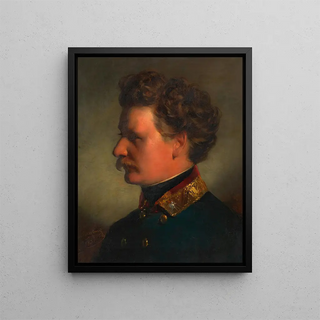Art print Joseph Georg Amerling in the role of the artist's elder brother - Friedrich von Amerling


View from behind

Frame (optional)
Joseph Georg Amerling art print of the artist's older brother - Friedrich von Amerling – Captivating introduction
In the vibrant universe of art, some works stand out for their ability to capture intimate moments and deep emotions. The art print of Joseph Georg Amerling portraying the artist's older brother - Friedrich von Amerling is a perfect example. This 19th-century masterpiece immerses us in a world where light and shadow intertwine to evoke the complexity of human relationships. Through the gaze of the older brother, the artist succeeds in conveying an atmosphere of both tenderness and melancholy, inviting the viewer to reflect on identity and lineage.
Style and uniqueness of the work
Friedrich von Amerling's style is characterized by striking realism that harmoniously blends with a touch of romanticism. In this piece, meticulously detailed, from the drapery of clothing to facial expressions, reveal undeniable technical mastery. The colors, delicate and nuanced, help create an intimate ambiance, where each element seems loaded with meaning. The posture of the brother, both solemn and approachable, suggests psychological depth that invites interpretation. Amerling does not merely depict a portrait; he tells a story, that of a fraternal bond filled with respect and complicity. This art print, through its aesthetic approach and emotional message, embodies the very essence of 19th-century art.
The artist and his influence
Friedrich von Amerling, born in 1803 in Vienna, is an iconic figure of the Austrian artistic movement. Influenced by the masters of the past, he developed a style that is uniquely his own, combining tradition and innovation. His training with renowned painters and his travels across Europe enriched his artistic language. Amerling captured the spirit of his time, leaving his mark on the art world with his striking portraits and depictions of everyday life. His influence extends beyond his era, inspiring many contemporary and future artists. By offering a window into the human soul, he paved the way for a deeper exploration of emotions in art, making him

Matte finish

View from behind

Frame (optional)
Joseph Georg Amerling art print of the artist's older brother - Friedrich von Amerling – Captivating introduction
In the vibrant universe of art, some works stand out for their ability to capture intimate moments and deep emotions. The art print of Joseph Georg Amerling portraying the artist's older brother - Friedrich von Amerling is a perfect example. This 19th-century masterpiece immerses us in a world where light and shadow intertwine to evoke the complexity of human relationships. Through the gaze of the older brother, the artist succeeds in conveying an atmosphere of both tenderness and melancholy, inviting the viewer to reflect on identity and lineage.
Style and uniqueness of the work
Friedrich von Amerling's style is characterized by striking realism that harmoniously blends with a touch of romanticism. In this piece, meticulously detailed, from the drapery of clothing to facial expressions, reveal undeniable technical mastery. The colors, delicate and nuanced, help create an intimate ambiance, where each element seems loaded with meaning. The posture of the brother, both solemn and approachable, suggests psychological depth that invites interpretation. Amerling does not merely depict a portrait; he tells a story, that of a fraternal bond filled with respect and complicity. This art print, through its aesthetic approach and emotional message, embodies the very essence of 19th-century art.
The artist and his influence
Friedrich von Amerling, born in 1803 in Vienna, is an iconic figure of the Austrian artistic movement. Influenced by the masters of the past, he developed a style that is uniquely his own, combining tradition and innovation. His training with renowned painters and his travels across Europe enriched his artistic language. Amerling captured the spirit of his time, leaving his mark on the art world with his striking portraits and depictions of everyday life. His influence extends beyond his era, inspiring many contemporary and future artists. By offering a window into the human soul, he paved the way for a deeper exploration of emotions in art, making him
12,34 €






